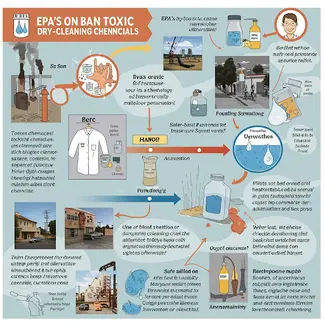
🚫 EPA Bans Toxic Dry-Cleaning Chemicals PCE and TCE
The U.S. Environmental Protection Agency (EPA) has announced a sweeping ban on two harmful chemicals commonly used in the dry-cleaning industry: perchloroethylene (PCE) and trichloroethylene (TCE).
These chemicals have long been known for their toxicity, and their ban represents a crucial step in protecting both workers and the environment from the dangers associated with their use.
🔍 Why the Ban Was Necessary
1. Health Risks
- PCE and TCE are linked to various forms of cancer.
- They can cause adverse effects on the nervous, immune, and reproductive systems.
- The EPA highlights significant risks for dry-cleaning workers regularly exposed to these chemicals.
2. Environmental Contamination
- These solvents have caused widespread soil and water pollution.
- They degrade very slowly and can remain in the environment for decades.
✅ Impact of the Ban on Dry-Cleaning Businesses
1. Worker Safety
- Protects those most at risk — dry-cleaning workers.
- Leads to better working conditions and health outcomes.
2. Transition to Safer Alternatives
- Many businesses will move to safer methods like:
- Wet cleaning
- CO₂ cleaning
- Biodegradable solvents
3. Environmental Benefits
- Less toxic waste and groundwater contamination.
- Healthier local ecosystems and communities.
🧹 Challenges in Transitioning to Safer Practices
1. High Initial Costs
- New equipment and training can be expensive.
- Small businesses may need financial support to adapt.
2. Training & Awareness
- Workers must be retrained to use safer technologies.
- Some business owners may be unaware of newer alternatives.
📊 Industry Adoption & Response
- Many businesses are already adopting green cleaning technologies.
- Companies like Lapels and Mulberrys Garment Care focus on eco-friendly branding.
- The EPA’s ban will likely accelerate industry-wide adoption of sustainable practices.
🔮 Future Outlook: A Greener, Safer Dry Cleaning Industry
1. Widespread Transition
- Eco-friendly dry cleaning methods are expected to become the norm.
2. Innovative, Safer Technologies
- Wet and CO₂ cleaning will keep improving, making the switch more viable for all businesses.
🏁 Conclusion
The EPA's ban on PCE and TCE marks a pivotal moment in the dry-cleaning industry.
It protects workers, reduces pollution, and pushes the industry toward greener solutions. Dry cleaners that adapt early will be better prepared for a future shaped by environmental responsibility and consumer demand for safe, sustainable services.
Secure Kiosk Mode
Lock your device to DryLaun, block unwanted apps, and keep your staff focused while managing your store with a secure, distraction-free laundry billing management system.
Learn More →

